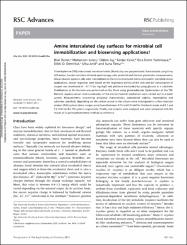Amine intercalated clay surfaces for microbial cell immobilization and biosensing applications

View/
Date
2013Author
Demir, BilalSeleci, Muharrem
Ag, Didem
Çevik, Serdar
Yalçınkaya, Esra Evrim
Demirkol, Dilek O.
Timur, Suna
Metadata
Show full item recordAbstract
Trimethylamine (TM) intercalated montmorillonite (Mont) clay was prepared and characterized using X-ray diffraction, Fourier transform infrared spectroscopy, zeta potential and thermal gravimetric measurements. Gluconobacter oxydans cells were immobilized on the micro-structured matrix and used in microbial sensor applications. Sensor responses were based on the respiratory activity of the cells and the consumption of oxygen was monitored at 20.7 V (vs. Ag/AgCl and platinum electrodes) by using glucose as a substrate. Stabilization of the bacteria was performed on the Mont using glutaraldehyde. Optimization of the TM-Mont/G. oxydans sensor and examination of the electrochemical mechanism were carried out in a batch system. Measurements concerning analytical characteristics, operational stability, repeatability and substrate specificity depending on the carbon source in the culture were investigated in a flow injection analysis (FIA) system. Linear ranges were found between 0.15 and 5.0 mM for the batch mode and 0.1 and 5.0 mM for the FIA system, respectively. Finally, real samples were analyzed and were compared with the results of a spectrophotometric method as reference.

















